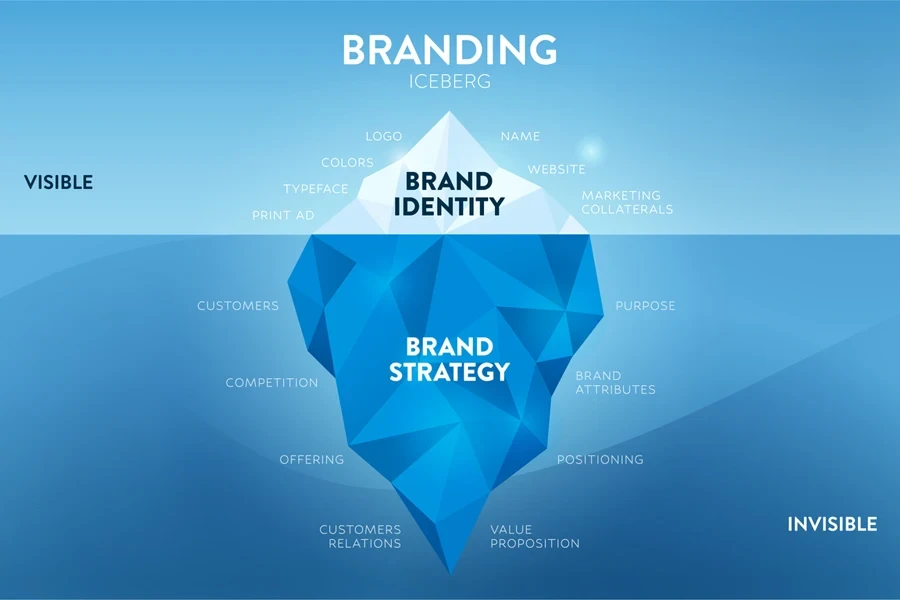In discussions about marketing, the term ‘brand strategy’ comes up often, so you’ve probably heard a brand strategy is critical to your success, but what is a brand strategy, and why is it important? That’s what we are here to answer.
Before discussing how to build an effective brand strategy, we will first define it and explain its importance.
Table of Contents
What is brand strategy, and why is it important?
The elements of a strong brand strategy
Step-by-step guide to building an effective brand strategy
Implementing your brand strategy
Common mistakes in brand strategy
What is brand strategy, and why is it important?

A brand strategy is the blueprint for creating a unique, consistent brand identity. It sets the foundation for all your marketing efforts and consumer interactions. It helps to ensure your brand is identifiable so you become the go-to choice in your business niche.
Your brand strategy will be grounded in market research so you know where you situate yourself in the market, and it is built on the how and why behind your business.
Why is a brand strategy important?
An effective brand strategy will guide you in making critical business decisions, helping you stand out in the market and establish long-term customers.
Additionally, a well-researched brand strategy will help your business mitigate risks and react to problems as it helps to provide a roadmap of how to react and adapt.
The key elements of a strong brand strategy

Your brand strategy will vary based on several factors, such as industry and business size. Still, there are several components that your brand strategy will be built on. These key elements include:
Purpose
Consider the purpose behind your business. Why do you exist? And what is your target market, ie. what part of the market are you trying to reach? Take the time to consider your customers’ needs and what problem your business helps them solve. This will help you understand and communicate your purpose.
For example, Patagonia’s brand purpose revolves around environmental activism and sustainability.
Brand values
Values help us guide our personal decision-making in our daily lives, and they are equally important in our business. Not only should your values guide your business decisions, but they should also align with the values your customers have.
For example, Honest Tea’s commitment to organic ingredients and fair trade practices reflects its brand values, building trust and credibility.
Brand voice and tone
Think of brand voice and tone as your brand’s personality. If your brand was a person, how would they communicate?
Your brand’s voice and tone are important because when potential customers read content created by your brand, they should be able to know it’s coming from you—it needs to be consistent.
Design and visual identity
Alongside brand voice, your brand should have a consistent visual identity. This includes essential things like your logo and brand colors. But you should also consider typography and graphics that align with your business’s purpose and values and resonate with your audience.
Once you’ve determined your brand voice and visual identity, it’s important to create branding guidelines that help ensure you keep this consistent across all marketing efforts. A branding guide is a physical document that includes information about the brand voice and tone and your logo, brand color palette, fonts and graphics styles to use. So, the message will be consistent no matter who creates content from your marketing team.
Brand story
Storytelling is an effective way of connecting with your audience on a more personal level. Your brand story is how you express what makes your business unique in the most interesting and compelling way.
Brand positioning
Your brand position is where you want to exist in the market and can be used as an elevator pitch for your business. It not only helps focus your marketing efforts and connect with your audience but also keeps your staff clear and aligned.
Tesla, for example, positions itself as a leader in electric vehicles, emphasizing innovation and environmental responsibility.
Step-by-step guide to building an effective brand strategy

Now that you know what a brand strategy is, it’s time to start building one of your own. As a critical element of your business and marketing strategy, it may seem daunting to create a brand strategy or know where to start. That’s why we’ve broken it down into steps.
Remember that market research plays a vital role in building your brand strategy. So, ensure you’re taking the time to research at every step of the process.
Step 1: Define your brand purpose and vision
The first step in building your brand strategy is understanding and outlining your purpose, which is why your brand exists and what it aims to achieve.
An important part of defining your brand purpose that you cannot forget about is– identifying your target audience. Without customers, your brand business will not succeed, so it’s critical to understand the needs and desires of your target audience.
Your overall brand purpose should align with your customers’ needs. So, alongside building an effective brand strategy, take some time to clarify your audience and conduct market research to uncover your buyer personas.
Step 2: Develop your brand position statement
Before determining your brand position statement, you must first determine your position. This means deciding what makes your brand unique and how you can stand out in a crowded marketplace.
Additionally, your brand positioning should align with your brand values, so now is a great time to define the core values that will guide your brand.
So, to define your brand position and create an effective positioning statement, ask yourself the following questions:
- Who are you targeting?
- What is the need you’re serving?
- Why should your audience believe you?
Step 3: Create compelling brand messaging
Your brand messaging is where you think about your brand voice and tone, which combine your brand values and positioning to determine how you will connect with your audience.
When creating your brand messaging, consider building it from the top down. This means starting with your brand positioning statement at the top and working your way down to the specific tone.
The brand tone is the attitude and character conveyed through your brand’s communication and includes the style, voice, and emotional nuance of your messaging.
Here, it can be helpful to think of your brand as a person (similar to how you think about segments of your audience as a single person in your buyer personas). When you think about your brand as a person, what characteristics would it have? How would they speak and behave? Write these down as tone descriptors, such as warm, authoritative, and witty.
For example, Old Spice’s brand personality is bold, humorous, and unconventional, which is reflected in their quirky and memorable advertising campaigns.
Step 4: Design your visual identity

Next is your visual identity. Work with a designer to create a logo, choose brand colors, and develop a visual style guide. Your visual identity should reflect your positioning statement and your values.
Step 5: Plan your brand experience
Your brand experience is how potential customers interact with your brand. Therefore, it’s essential to consider every customer touch point and ensure brand consistency.
Start by aligning your messaging and visuals on your website and social media channels. Social media plays a critical role in brand awareness, so using it to reach your target audience is critical.
The next step is to align your marketing efforts. Use your brand strategy to create compelling marketing strategies that align with your brand’s values and purpose. Brand guidelines can help ensure consistency in all marketing messaging and visuals.
Implementing your brand strategy

Now that you have your brand strategy, it’s time to implement it. Note that implementing your brand strategy is an ongoing process, as it’s something you will take into account every time you interact with your customers—from creating new blogs to writing social media posts and product descriptions to creating effective ad campaigns.
Here are some critical things to consider when implementing your brand strategy:
Aligning your team
Your team is your best resource, so all teams need to be aligned on the brand’s values and goals.
Your role as a business is clearly communicating the brand values and position to all employees and providing training, resources, and feedback to help them effectively deliver on the brand promise.
Tell your brand story
Your story is a big part of what makes your business unique, so ensure you’re telling this story. Your website should have an About section to communicate your brand story to your audience along with your mission statement.
You can also use your blog and social media to tell authentic stories about your brand that build connections with your audience. According to Sprout Social, 91% of people believe in social media’s power to connect people.
Consistency across channels
As we’ve mentioned, consistency is critical to building your brand—that’s the purpose of having a comprehensive brand strategy. According to a Lucidpress report, consistent brand presentation across all platforms can increase revenue by up to 23%.
So, ensure you build branding guidelines based on your brand strategy and give these to all employees who create brand resources, messaging, or interact with customers.
Tracking and measuring success
Brand strategy is a continuous process that requires ongoing improvement over time. So, it’s crucial to analyze your audience’s response and change things that aren’t working.
It’s also important to gather and listen to customer feedback and be prepared to make adjustments where necessary. For instance, when Coca-Cola introduced New Coke, the negative feedback was overwhelming, leading the company to quickly return to its original formula.
A part of this process is also monitoring how your competitors are positioning themselves.
Common mistakes in brand strategy
Building and executing a brand strategy can be a complicated and challenging process, so it can be easy to make mistakes. Here are some common brand strategy mistakes and how to avoid them:
Inconsistent brand messaging
As we’ve highlighted throughout this article, consistent brand messaging is critical. Inconsistent brand messaging across channels creates confusion and weakens brand identity.
How to avoid:
- Develop a brand style guide outlining your voice, tone, and visual elements.
- Train employees and partners to adhere to these guidelines.
Overcomplicating the brand
As with inconsistent brand messaging, overcomplicating the brand and its messaging can confuse your audience and dilute your brand identity. For example, Yahoo! struggled with a lack of clear focus and consistency, offering a wide range of services without a coherent strategy.
How to avoid:
- Keep your brand strategy simple and focused.
- Concentrate on your core strengths and values.
- Communicate your brand message clearly and concisely.
Neglecting internal branding
Internal branding ensures employees understand and embody the brand values. Not considering internal branding can lead to inconsistent messaging.
How to avoid: Ensure your employees understand and embody your brand values and foster a positive workplace culture that aligns with your brand promise.
Failing to evolve
Like people, the market is continually evolving, and your strategy needs to grow with it, or your business could become obsolete or out of touch.
Blockbuster’s downfall is a cautionary tale of failing to evolve. Despite the rise of digital streaming services like Netflix, Blockbuster remained committed to its physical rental model for too long. Their inability to adapt to changing consumer preferences led to their eventual bankruptcy.
How to avoid:
- Regularly review market trends and consumer behaviors.
- Innovate and update your offerings to stay relevant.
Build a winning brand strategy today

A strong brand strategy sets the foundation for building a unique identity, fostering loyalty, and standing out in a crowded market. By understanding your purpose, knowing your audience, and consistently delivering on your brand promise, you can create a brand that resonates with consumers and drives long-term success.
As you embark on this journey, remember your brand is more than just a logo or a tagline—it embodies your values, vision, and the experience you deliver to your customers. So, take the time to build it right.




